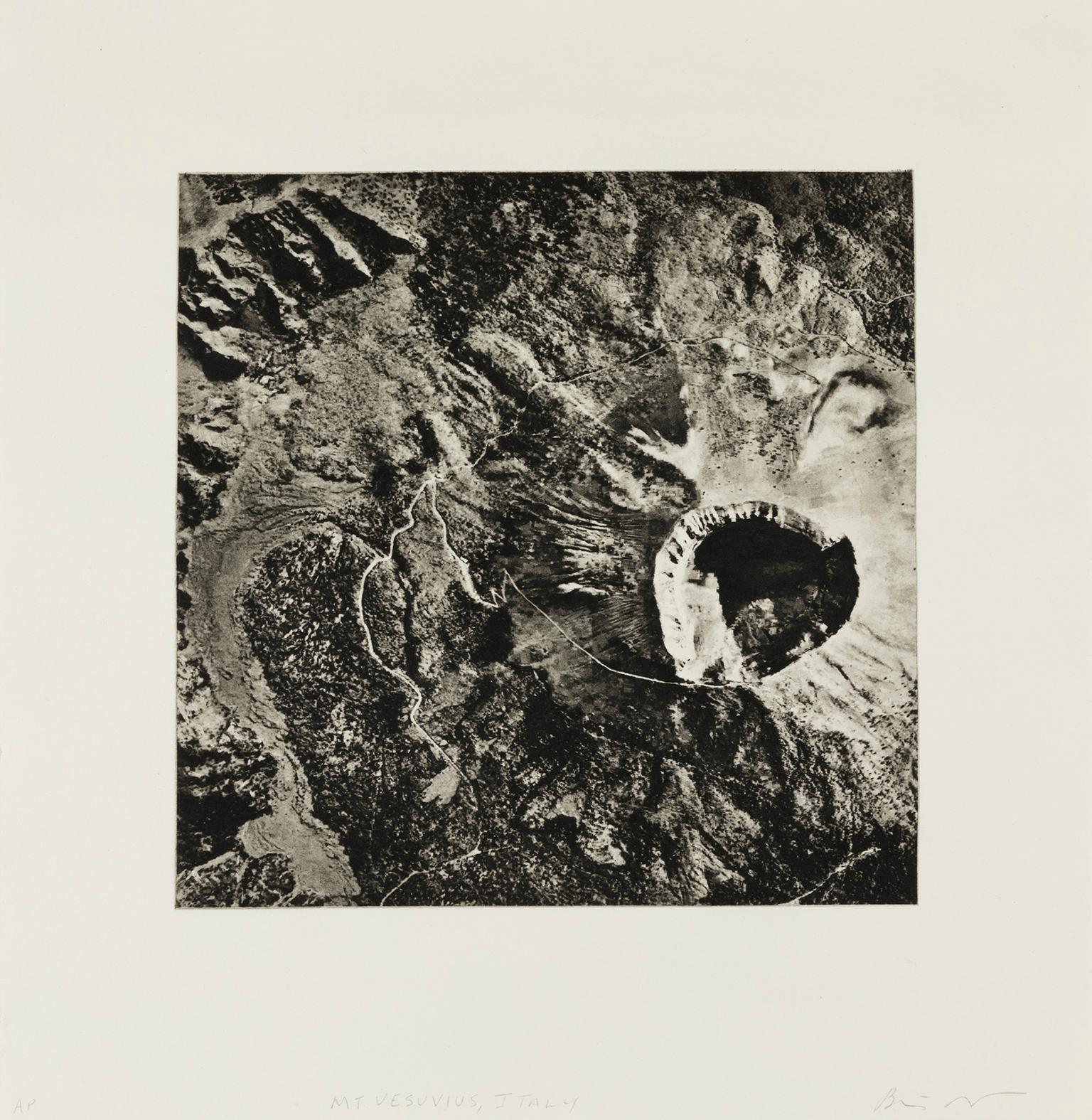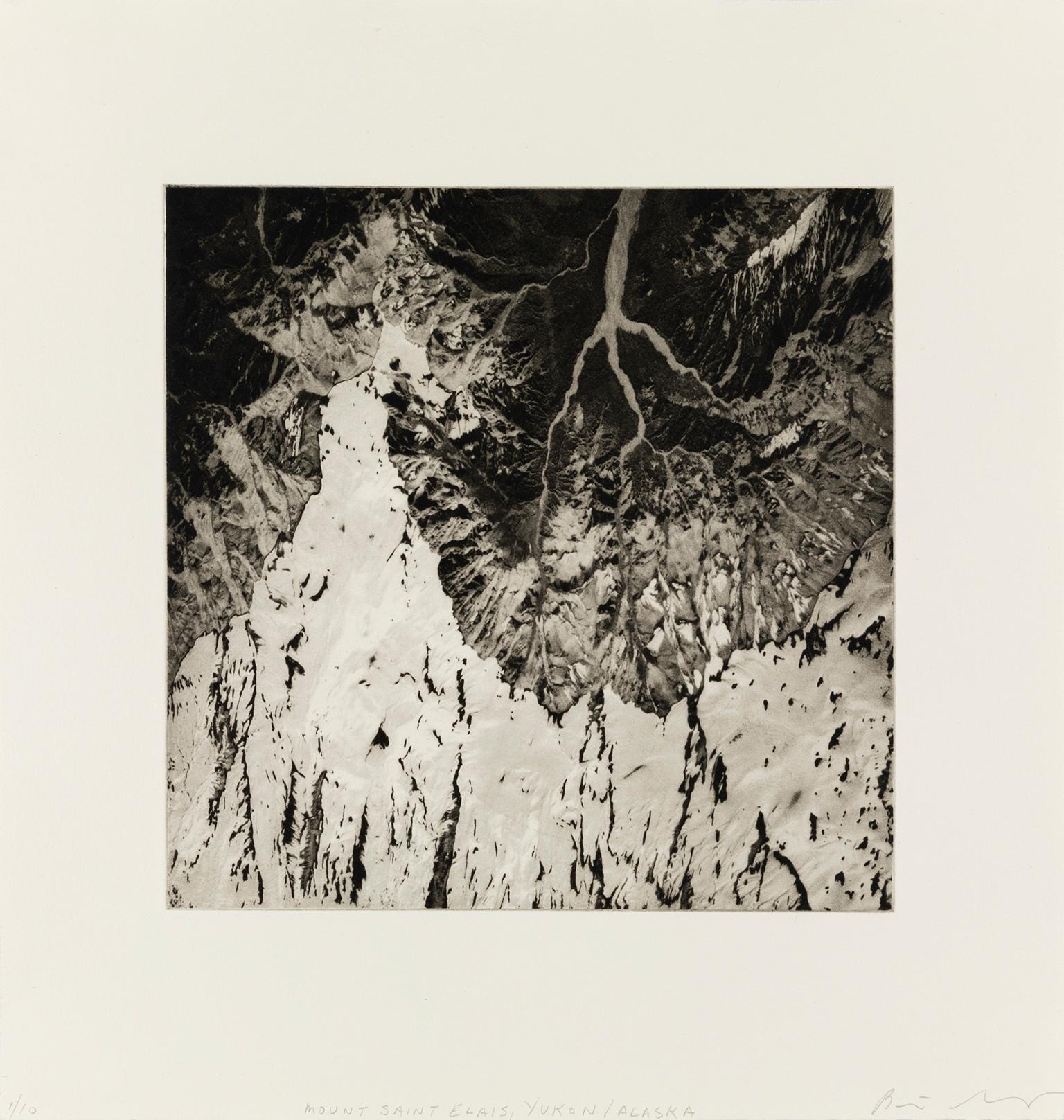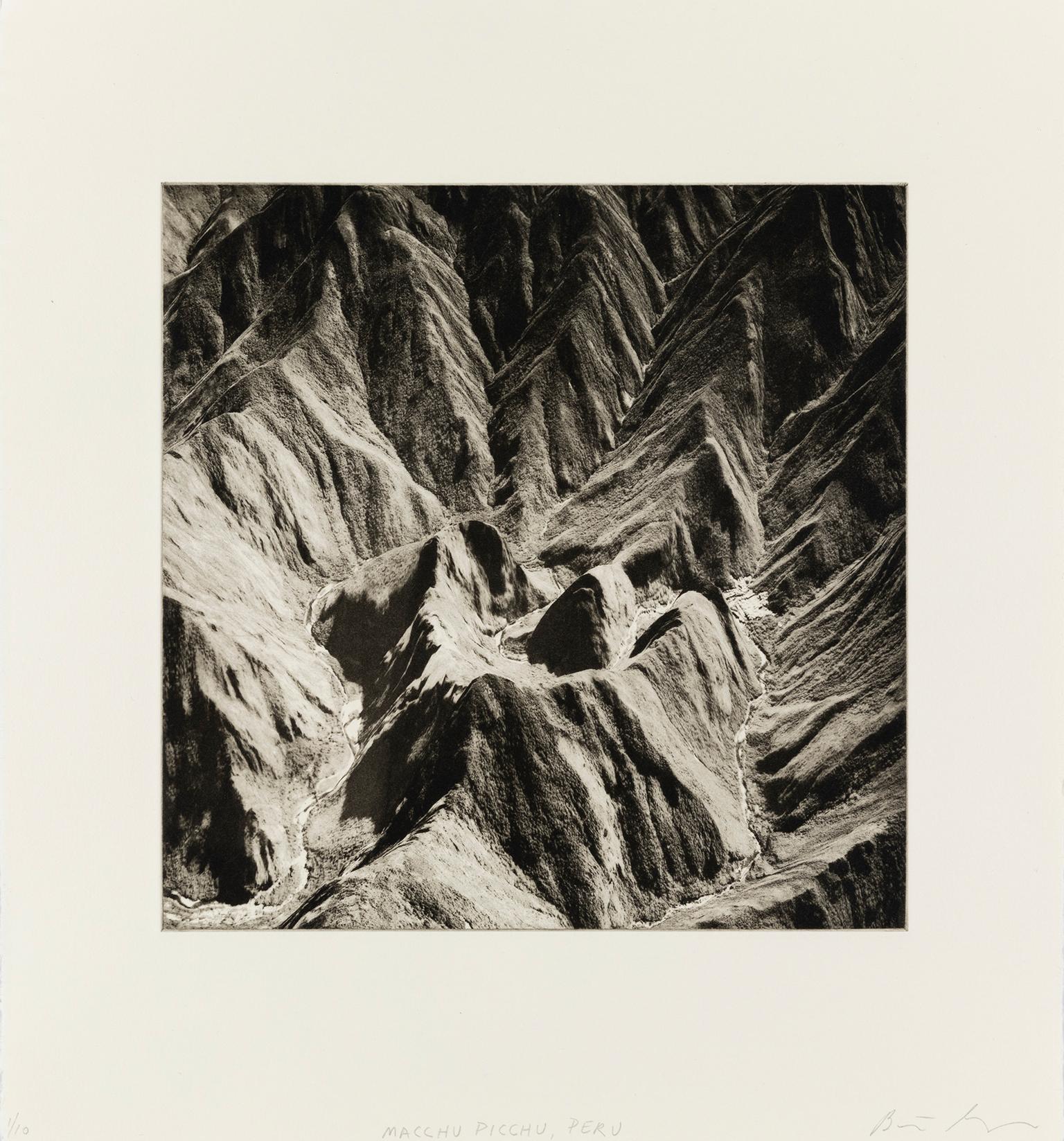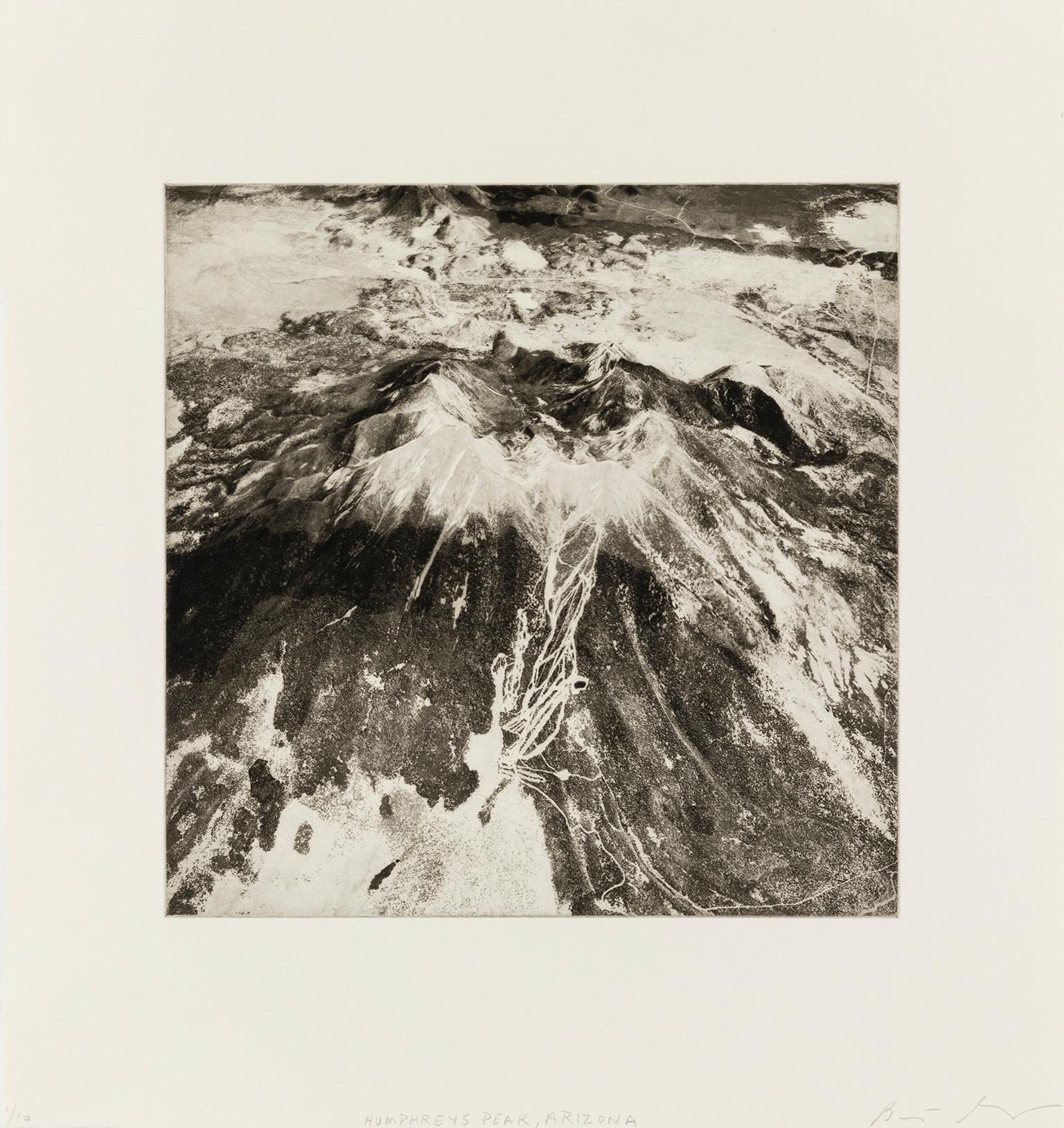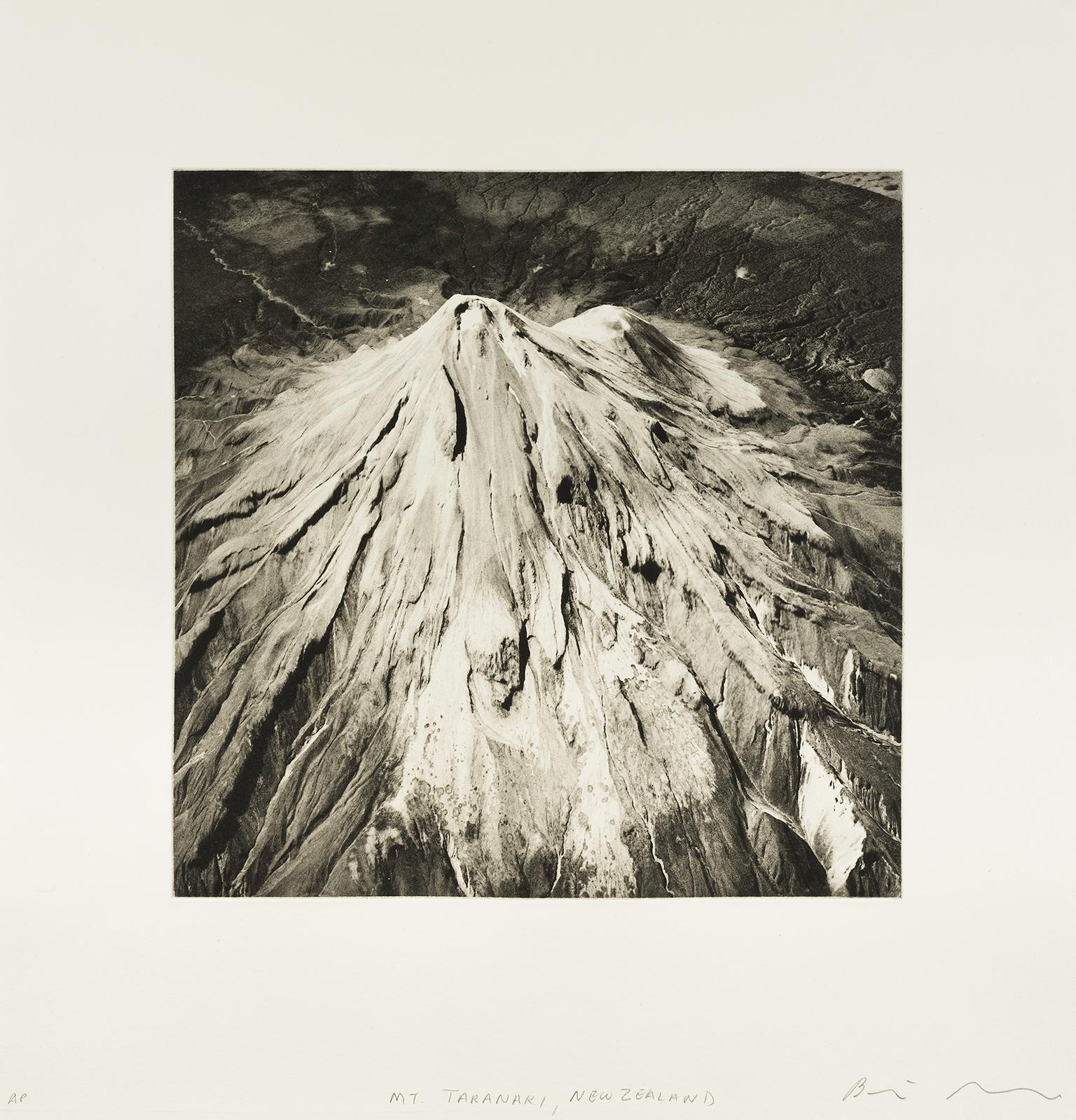Items Similar to 'Adam's Peak, Sri Lanka' — from the series 'Axis Mundi', Contemporary
Want more images or videos?
Request additional images or videos from the seller
1 of 8
Beth Ganz'Adam's Peak, Sri Lanka' — from the series 'Axis Mundi', Contemporary2020
2020
About the Item
Beth Ganz, 'Adam's Peak, Sri Lanka', copperplate photogravure etching, edition 10, 2020. Signed, titled, and numbered 6/10 in pencil. A superb, richly-inked impression in warm black ink, on cream, wove, cotton rag paper; the full sheet in excellent condition. Image size 10 1/2 x 10 1/2 inches; sheet size 16 x 15 1/2 inches. Archivally sleeved, unmatted.
From the artist's series of 64 photogravure etchings, 'Axis Mundi'. Additional works from the series are available; please inquire.
Exhibited: 'Photography in Ink, A Look at Contemporary Copper-Plate Photogravure,' Curated by Leandro Villaro, Penumbra Exhibition Space Gallery, Nov 30, 2022 - March 15, 2023.
ABOUT THE IMAGE
Adam's Peak is a 2,243 m (7,359 ft) tall conical mountain located in the southern reaches of the Central Highlands of Sri Lanka. Revered as a holy site by Buddhists, Hindus, Muslims, and Christians, it is well known for the Sri Pada, "sacred footprint," a 1.8 m (5 ft 11 in) rock formation near the summit, which in the Buddhist tradition is held to be the footprint of the Buddha, in Hindu tradition that of Hanuman or Shiva, i.e., "Mountain of Shiva's Light." Some Muslims and Christians in Sri Lanka ascribe it to where Adam, the first ancestor, set foot as he was exiled from the Garden of Eden. The legends of Adam are connected to the idea that Sri Lanka was the original Eden, and in the Muslim tradition, Adam was 60 cubits tall.
A shrine to Saman, a Buddhist "deity" (seekers who have devoted their lives to spiritual values are deified by Sri Lankan Buddhists) charged with protecting the mountaintop, can be found near the footprint. A bell lies on top of the temple, and tradition holds that pilgrims ring it as many times as they have achieved the pilgrimage to the top of the peak.
Sri Pada is first mentioned (as Samanthakuta) in the Deepawamsa, the earliest Pali chronicle, (4th century), and also in the 5th-century register Mahawamsa, where it is stated that the Buddha visited the mountain peak. The log Rajavaliya records that King Valagamba (1st century BCE) had taken refuge in the forests of Adam's Peak against invaders from India, and later returned to Anuradhapura. The Mahawamsa again mentions the visit of King Vijayabahu I (1058–1114) to the mountain. The famous Chinese pilgrim and Buddhist traveler Fa Hien stayed in Sri Lanka in 411–12 CE and mentions Sri Pada. The Italian merchant Marco Polo in his Travels of 1298 CE, noted that Adam's Peak was an important place of pilgrimage. The Arab traveler Ibn Battuta climbed to the summit, which he called Sarandīb, in 1344 CE. In his description, he mentions a stairway and iron stanchions with chains to aid pilgrims in the climb.
ABOUT THE SERIES 'AXIS MUNDI'
"This body of work focuses on satellite images of sacred mountains around the world—places where heaven and earth are thought to meet. The phenomenon of revering mountains as holy sites is an archetype found in many cultures.
"This shared experience finds a visual echo in the ubiquity of images of the earth that are now available to any person with a computer and an Internet connection. What does the specificity of place mean when we can move across the surface of the earth in seconds and reduce everything to a series of pixels? To me, this process recalls abstract painting, which transforms the specific into gesture and form. Rather than treat digital technology as necessarily destructive to human meaning and experience, my work offers new ways of seeing that are reconcilable with the old. To this end, I combine 19th Century Photogravure technique with 21st Century surveillance captures.
"Axis Mundi consists of 64 copperplate photogravures. The work is laid out in a grid, which is an arbitrary conversion of the visual world into a flat space that happens both on the picture plane and in the data processing. The title refers to the belief in a 'world center,' often conceived of as a mountain: a place where communication between higher and lower realms is possible. This project is a search for such a center in a world of decentralization and fragmentation."
—Beth Ganz
ABOUT THE ARTIST
Beth Ganz is a contemporary American multidisciplinary visual artist, who lives and works in New York City. She graduated from Pratt Institute with a BFA (honors) in Painting, Sculpture, and Printmaking. The focus of her work is the intersection of landscape, digital technology, and abstraction. Ganz works in paint, brush, and ink drawing, both independently and alongside digital and analog printing techniques, including photogravure and intaglio printing.
Ganz’s work has been the subject of many solo exhibitions, including 'Atlas Project' at Cynthia-Reeves Gallery, 'Up Close and Far Away, Grids and Toiles: Beth Ganz at Wave Hill House,' Wave Hill, and 'Geothermal Topographies' at Reeves Contemporary. She has been shown in numerous group exhibitions, and her work is represented in many public and private collections, including the 9-11 Memorial Museum, the Library of Congress, the New York Historical Society, and the New York Public Library Prints Collection.
Ganz teaches workshops in photogravure and intaglio at Manhattan Graphics Center and has been a long-time grantee of the Elizabeth Foundation for the Arts.
AWARDS AND RESIDENCIES
2018 – Signal: Tri-State Juried Exhibition (2nd Place), Katonah Museum of Art, Katonah, New York (Juror: Lumi Tan)
2001-2014 – Studio Program, Elizabeth Foundation for the Arts, New York, NY
2005 – Johnson & Johnson Purchase Prize, 48th Annual National Print Exhibition, Hunterdon Museum of Art, Clinton, NJ
1999 – Prints USA Juror’s Award, Springfield Art Museum, Springfield, MO
1993 – 37th Annual National Print Exhibition (Honorable Mention), Hunterdon Art Center, Clinton, NJ
1992 – Small Impressions 1992 (Juror’s Award), Printmaking Council of New Jersey, NJ
BIBLIOGRAPHY: MAGAZINES, JOURNALS, NEWSPAPERS, AND ONLINE MEDIA
2018 – Mary Legrand, “A Signal of Invention,” Bedford Record, July 2018
2017 – Sara Mintz, “Profile of an Artist: Beth Ganz,” Journal of the Print World, Vol. 40, #4, October 2017
2017 – Cate McQuaid, “Critics’ Picks, The Ticket: Music, Theater, Dance, Art and more,” Boston Globe, May 2017 4, 2017
2017 – Beth Ganz, “New Prints: Beth Ganz and the Atlas Project Landscape,” Journal of the Print World, I Vol. 40, #3, July 2017
Collections: Duke Energy, Charlotte, NC; Evelyn Lauder Breast Center at SKMCC, New York, NY; Frost Bank, Houston, Texas; Hofstra Museum, Hofstra University; Johnson and Johnson Corporate Collection, NJ; Library of Congress, Washington, DC; New York Historical Society; New York Public Library Prints Collection; Norwegian Cruise Lines Corporation (Commission for the BLISS Cruise Ship); NYU Langone Health, New York, NY; Permanent Collection of the US Consulate, Cape Town, South Africa; Squib Corporation Collection, NJ; 9-11 Memorial Museum, New York, NY; Tommy Hilfiger Corporate Collection, New York, NY; United States Embassy Permanent Collection, Tbilisi, Georgia; Universal Studios, Los Angeles, CA; US Department of State, Art Bank Program, Washington, DC.
- Creator:
- Creation Year:2020
- Dimensions:Height: 10.5 in (26.67 cm)Width: 10.5 in (26.67 cm)
- Medium:
- Movement & Style:
- Period:
- Condition:
- Gallery Location:Myrtle Beach, SC
- Reference Number:
About the Seller
5.0
Recognized Seller
These prestigious sellers are industry leaders and represent the highest echelon for item quality and design.
Platinum Seller
These expertly vetted sellers are 1stDibs' most experienced sellers and are rated highest by our customers.
Established in 1995
1stDibs seller since 2016
254 sales on 1stDibs
Typical response time: 2 hours
Associations
International Fine Print Dealers Association
- ShippingRetrieving quote...Ships From: Myrtle Beach, SC
- Return PolicyA return for this item may be initiated within 7 days of delivery.
More From This SellerView All
- 'Mount Vesuvius, Italy' — from the series 'Axis Mundi', ContemporaryLocated in Myrtle Beach, SCBeth Ganz, 'Mount Vesuvius, Italy', copperplate photogravure etching, edition 10, 2020. Signed, titled, and numbered 6/10 in pencil. A superb, richly-inked impression in warm black ink, on cream, wove, cotton rag paper; the full sheet in excellent condition. Archivally sleeved, unmatted. Image size 10 1/2 x 10 1/2 inches; sheet size 16 x 15 1/2 inches. From the artist's series of 64 photogravure etchings 'Axis Mundi'. Additional works from the series are available; please inquire. Exhibited: 'Photography in Ink, A Look at Contemporary Copper-Plate Photogravure,' Curated by Leandro Villaro, Penumbra Exhibition Space Gallery, Nov 30, 2022 - March 15, 2023. ABOUT THE IMAGE Mount Vesuvius (Italian: Vesuvio) is a somma-stratovolcano located on the Gulf of Naples in Campania, Italy, about 9 km (5.6 mi) east of Naples and a short distance from the shore. It is one of several volcanoes forming the Campanian volcanic arc. Vesuvius consists of a large cone partially encircled by the steep rim of a summit caldera, resulting from the collapse of an earlier, much higher structure. The eruption of Mount Vesuvius in AD 79, one of the most catastrophic eruptions of all time, destroyed the Roman cities of Pompeii, Herculaneum, Oplontis, Stabiae, and several other settlements. The eruption ejected a cloud of stones, ashes and volcanic gases to a height of 33 km (21 mi). More than 1,000 people are thought to have died in the eruption. Vesuvius has erupted about three dozen times since. It is the only volcano on Europe's mainland to have erupted in the last hundred years (1929 and 1944). It is regarded as one of the most dangerous volcanoes in the world—3,000,000 people live near enough to be affected by an eruption, with at least 600,000 in the danger zone, the most densely populated volcanic region in the world. Eruptions tend to be violent and explosive; these are known as Plinian eruptions. Vesuvius has a long historical and literary tradition. It was considered a divinity of the Genius type (a divine nature much like a guardian angel) at the time of the eruption of AD 79: it appears under the inscribed name Vesuvius as a serpent in the decorative frescos of many household shrines, surviving from Pompeii. The Romans regarded Mount Vesuvius as being devoted to Hercules. The historian Diodorus Siculus relates a tradition that Hercules, in the performance of his labors, passed through the country of nearby Cumae on his way to Sicily and found there a place called 'the Phlegraean Plain' ('plain of fire') 'from a hill which anciently vomited out fire ... now called Vesuvius.' It was inhabited by giant bandits, 'the sons of the Earth'. With the gods' assistance, he pacified the region and continued his journey. The area around Vesuvius was officially declared a national park on June 5, 1995. The summit of Vesuvius is open to visitors, and the park authorities maintain a small network of paths around the volcano. There is access by road to within 200 meters (660 ft) of the summit and a spiral walkway around the volcano from the road to the crater. ABOUT THE SERIES 'AXIS MUNDI' "This body of work focuses on satellite images of sacred mountains around the world—places where heaven and earth are thought to meet. The phenomenon of revering mountains as holy sites is an archetype found in many cultures. "This shared experience finds a visual echo in the ubiquity of images of the earth that are now available to any person with a computer and an Internet connection. What does the specificity of place mean when we can move across the surface of the earth in seconds and reduce everything to a series of pixels? To me, this process recalls abstract painting, which transforms the specific into gesture and form. Rather than treat digital technology as necessarily destructive to human meaning and experience, my work offers new ways of seeing that are reconcilable with the old. To this end, I combine 19th Century Photogravure technique with 21st Century surveillance captures. "Axis Mundi consists of 64 copperplate photogravures. The work is laid out in a grid, which is an arbitrary conversion of the visual world into a flat space that happens both on the picture plane and in the data processing. The title refers to the belief in a 'world center,' often conceived of as a mountain: a place where communication between higher and lower realms is possible. This project is a search for such a center in a world of decentralization and fragmentation." —Beth Ganz ABOUT THE ARTIST Beth Ganz is a contemporary American multidisciplinary visual artist, who lives and works in New York City. She graduated from Pratt Institute with a BFA (honors) in Painting, Sculpture, and Printmaking. The focus of her work is the intersection of landscape, digital technology, and abstraction. Ganz works in paint, brush, and ink drawing, both independently and alongside digital and analog printing techniques, including photogravure and intaglio printing. Ganz’s work has been the subject of many solo exhibitions, including 'Atlas Project' at Cynthia-Reeves Gallery, 'Up Close and Far Away, Grids and Toiles: Beth Ganz at Wave Hill House,' Wave Hill, and 'Geothermal Topographies' at Reeves Contemporary. She has been shown in numerous group exhibitions, and her work is represented in many public and private collections, including the 9-11 Memorial Museum, the Library of Congress, the New York Historical Society, and the New York Public Library Prints...Category
21st Century and Contemporary Contemporary Landscape Prints
MaterialsPhotogravure, Etching
- 'Mount St. Elias, Yukon, Alaska' — from the series 'Axis Mundi', ContemporaryLocated in Myrtle Beach, SCBeth Ganz, 'Mount St. Elias, Yukon, Alaska', copperplate photogravure etching, edition 10, 2021. Signed, titled, and numbered 6/10 in pencil. A superb, richly-inked impression in warm black ink, on cream, wove, cotton rag paper; the full sheet in excellent condition. Archivally sleeved, unmatted. Image size 10 1/2 x 10 1/2 inches; sheet size 16 x 15 1/2 inches. From the artist's series of 64 photogravure etchings 'Axis Mundi'. Additional works from the series are available; please inquire. Exhibited: 'Photography in Ink, A Look at Contemporary Copper-Plate Photogravure,' Curated by Leandro Villaro, Penumbra Exhibition Space Gallery, Nov 30, 2022 - March 15, 2023. ABOUT THE IMAGE Mount Saint Elias, the second-highest mountain in Canada and the United States stands on the Yukon and Alaska border about 26 miles (42 km) southwest of Mount Logan, the highest mountain in Canada. The Canadian side of Mount Saint Elias forms part of Kluane National Park and Reserve, while the U.S. side is within Wrangell-St. Elias National Park and Preserve. Mount Saint Elias is notable for its immense vertical relief. Its summit rises 18,008 feet (5,489 m) vertically in just 10 miles (16 km) horizontal distance from the head of Taan Fjord, off of Icy Bay. The name of the mountain in Tlingit (indigenous peoples of the Pacific Northwest Coast of North America), Yasʼéitʼaa Shaa, means "mountain behind Icy Bay"; the Yakutat Tlingit occasionally call it Shaa Tlein "Big Mountain". It is one of the most important crests of the Kwaashkʼiḵwáan clan, who used it as a guide during their journey down the Copper River. Mount Fairweather, at the apex of the British Columbia and Alaska borders at the head of the Alaska Panhandle, is known as Tsalx̱aan; legend states that this mountain and Yasʼéitʼaa Shaa (Mt. St. Elias) originally stood next to each other, but had an argument and separated. Their children, the mountains between the two peaks, are called Tsalx̱aan Yátxʼi ("Children of Tsalxaan"). European explorers first sighted the mountain on July 16, 1741, with the arrival of the expedition commanded by Vitus Bering, a Danish explorer in service of Russia. While some historians contend that Bering named the mountain, others believe that eighteenth-century mapmakers named it after Cape Saint Elias when Bering left the peak unnamed. Mt. St. Elias was first climbed on July 31, 1897, by an Italian expedition led by famed explorer Prince Luigi Amedeo, Duke of the Abruzzi (who also reconnoitered the current standard route on K2 in 1909) and included noted mountain photographer Vittorio Sella. In 2007 Gerald Salmina directed an Austrian documentary film, Mount St. Elias, about a team of skiers/mountaineers determined to make "the planet's longest skiing descent" by ascending the mountain and then skiing nearly all 18,000 feet down to the Gulf of Alaska; the movie finished editing and underwent limited release in 2009. The climbers ended up summiting on the second attempt and skiing down to 13,000 ft (3,960 m). ABOUT THE SERIES 'AXIS MUNDI' "This body of work focuses on satellite images of sacred mountains around the world—places where heaven and earth are thought to meet. The phenomenon of revering mountains as holy sites is an archetype found in many cultures. "This shared experience finds a visual echo in the ubiquity of images of the earth that are now available to any person with a computer and an Internet connection. What does the specificity of place mean when we can move across the surface of the earth in seconds and reduce everything to a series of pixels? To me, this process recalls abstract painting, which transforms the specific into gesture and form. Rather than treat digital technology as necessarily destructive to human meaning and experience, my work offers new ways of seeing that are reconcilable with the old. To this end, I combine 19th Century Photogravure technique with 21st Century surveillance captures. "Axis Mundi consists of 64 copperplate photogravures. The work is laid out in a grid, which is an arbitrary conversion of the visual world into a flat space that happens both on the picture plane and in the data processing. The title refers to the belief in a 'world center,' often conceived of as a mountain: a place where communication between higher and lower realms is possible. This project is a search for such a center in a world of decentralization and fragmentation." —Beth Ganz ABOUT THE ARTIST Beth Ganz is a contemporary American multidisciplinary visual artist, who lives and works in New York City. She graduated from Pratt Institute with a BFA (honors) in Painting, Sculpture, and Printmaking. The focus of her work is the intersection of landscape, digital technology, and abstraction. Ganz works in paint, brush, and ink drawing, both independently and alongside digital and analog printing techniques, including photogravure and intaglio printing. Ganz’s work has been the subject of many solo exhibitions, including 'Atlas Project' at Cynthia-Reeves Gallery, 'Up Close and Far Away, Grids and Toiles: Beth Ganz at Wave Hill House,' Wave Hill, and 'Geothermal Topographies' at Reeves Contemporary. She has been shown in numerous group exhibitions, and her work is represented in many public and private collections, including the 9-11 Memorial Museum, the Library of Congress, the New York Historical Society, and the New York Public Library Prints...Category
21st Century and Contemporary Contemporary Landscape Prints
MaterialsPhotogravure, Etching
- 'Machu Picchu, Peru' — from the series 'Axis Mundi', ContemporaryLocated in Myrtle Beach, SCBeth Ganz, 'Machu Picchu, Peru', copperplate photogravure etching, edition 10, 2021. Signed, titled, and numbered 6/10 in pencil. A superb, richly-inked i...Category
21st Century and Contemporary Contemporary Landscape Prints
MaterialsPhotogravure, Etching
- 'Humphrey's Peak, Arizona' — from the series 'Axis Mundi', ContemporaryLocated in Myrtle Beach, SCBeth Ganz, 'Humphrey's Peak, Arizona', copperplate photogravure etching, edition 10, 2021. Signed, titled, and numbered 6/10 in pencil. A superb, richly-inked impression in warm black ink, on cream, wove, cotton rag paper; the full sheet in excellent condition. Archivally sleeved, unmatted. Image size 10 1/2 x 10 1/2 inches; sheet size 16 x 15 1/2 inches. From the artist's series of 64 photogravure etchings, 'Axis Mundi'. Additional works from the series are available; please inquire. Exhibited: 'Photography in Ink, A Look at Contemporary Copper-Plate Photogravure,' Curated by Leandro Villaro, Penumbra Exhibition Space Gallery, Nov 30, 2022 - March 15, 2023. ABOUT THE IMAGE Humphreys Peak (Hopi: Aaloosaktukwi, Navajo: Dookʼoʼoosłííd) is the highest natural point and the second most prominent peak after Mount Graham in the U.S. state of Arizona, with an elevation of 12,637 feet (3,852 m) and is located within the Kachina Peaks Wilderness in the Coconino National Forest, about 11 miles (17.7 km) north of Flagstaff, Arizona. Humphreys Peak is the highest of a group of dormant volcanic peaks known as the San Francisco Peaks. Humphreys Peak was named in about 1870 for General Andrew A. Humphreys, a U.S. Army officer who was a Union general during the American Civil War and who later became Chief of Engineers of the United States Army Corps of Engineers. The San Francisco Peaks are a sacred place for Hopi, Navajo, Havasupai, Zuni, Apache, and other Native American tribes. A place of sacred shrines and ancestral dwellings, The Peaks are associated with emergence, deities, ancestors, life-giving moisture, and spiritual ceremony and are still actively utilized today. Numerous medicinal herbs and other plants used in traditional ceremonies and to treat ailments are found at several levels of the Peaks. The plants are said to have place-specific energies—that is, they must come from these sacred sites to fulfill their proper function. To the Hopi, the Peaks are Nuvatukaovi, “The Place of Snow on the Very Top,” home for half the year to the ancestral kachina spirits who live among the clouds around the summit. When properly honored through song and ceremony, it is believed that the kachinas will bring gentle rains to thirsty crops. ABOUT THE SERIES 'AXIS MUNDI' "This body of work focuses on satellite images of sacred mountains around the world—places where heaven and earth are thought to meet. The phenomenon of revering mountains as holy sites is an archetype found in many cultures. "This shared experience finds a visual echo in the ubiquity of images of the earth that are now available to any person with a computer and an Internet connection. What does the specificity of place mean when we can move across the surface of the earth in seconds and reduce everything to a series of pixels? To me, this process recalls abstract painting, which transforms the specific into gesture and form. Rather than treat digital technology as necessarily destructive to human meaning and experience, my work offers new ways of seeing that are reconcilable with the old. To this end, I combine 19th Century Photogravure technique with 21st Century surveillance captures. "Axis Mundi consists of 64 copperplate photogravures. The work is laid out in a grid, which is an arbitrary conversion of the visual world into a flat space that happens both on the picture plane and in the data processing. The title refers to the belief in a 'world center,' often conceived of as a mountain: a place where communication between higher and lower realms is possible. This project is a search for such a center in a world of decentralization and fragmentation." —Beth Ganz ABOUT THE ARTIST Beth Ganz is a contemporary American multidisciplinary visual artist, who lives and works in New York City. She graduated from Pratt Institute with a BFA (honors) in Painting, Sculpture, and Printmaking. The focus of her work is the intersection of landscape, digital technology, and abstraction. Ganz works in paint, brush, and ink drawing, both independently and alongside digital and analog printing techniques, including photogravure and intaglio printing. Ganz’s work has been the subject of many solo exhibitions, including 'Atlas Project' at Cynthia-Reeves Gallery, 'Up Close and Far Away, Grids and Toiles: Beth Ganz at Wave Hill House,' Wave Hill, and 'Geothermal Topographies' at Reeves Contemporary. She has been shown in numerous group exhibitions, and her work is represented in many public and private collections, including the 9-11 Memorial Museum, the Library of Congress, the New York Historical Society, and the New York Public Library Prints Collection. Ganz teaches workshops in photogravure and intaglio at Manhattan Graphics Center and has been a long-time grantee of the Elizabeth Foundation for the Arts. AWARDS AND RESIDENCIES 2018 – Signal: Tri-State Juried Exhibition (2nd Place), Katonah Museum of Art, Katonah, New York (Juror: Lumi Tan) 2001-2014 – Studio Program, Elizabeth Foundation for the Arts, New York, NY 2005 – Johnson & Johnson Purchase Prize, 48th Annual National Print Exhibition, Hunterdon Museum of Art, Clinton, NJ 1999 – Prints USA Juror’s Award, Springfield Art Museum, Springfield, MO 1993 – 37th Annual National Print Exhibition (Honorable Mention), Hunterdon Art Center, Clinton, NJ 1992 – Small Impressions 1992 (Juror’s Award), Printmaking Council of New Jersey, NJ BIBLIOGRAPHY: MAGAZINES, JOURNALS, NEWSPAPERS, AND ONLINE MEDIA 2018 – Mary Legrand, “A Signal of Invention,” Bedford Record, July 2018 2017 – Sara Mintz, “Profile of an Artist: Beth Ganz,” Journal of the Print World, Vol. 40, #4, October 2017 2017 – Cate McQuaid, “Critics’ Picks, The Ticket: Music, Theater, Dance, Art and more,” Boston Globe, May 2017 4, 2017 2017 – Beth Ganz, “New Prints: Beth Ganz and the Atlas Project Landscape,” Journal of the Print World, I Vol. 40, #3, July 2017 Collections: Duke Energy, Charlotte, NC; Evelyn Lauder Breast Center at SKMCC, New York, NY; Frost Bank, Houston, Texas; Hofstra Museum, Hofstra University; Johnson and Johnson...Category
21st Century and Contemporary Contemporary Landscape Prints
MaterialsPhotogravure, Etching
- 'Lomagnupur, South Iceland' — from the series 'Axis Mundi', ContemporaryLocated in Myrtle Beach, SCBeth Ganz, 'Lomagnupur, South Iceland', copperplate photogravure etching, edition 10, 2021. Signed, titled, and numbered 6/10 in pencil. A superb, richly-inked impression in warm black ink, on cream, wove, cotton rag paper; the full sheet in excellent condition. Archivally sleeved, unmatted. Image size 10 1/2 x 10 1/2 inches; sheet size 16 x 15 1/2 inches. From the artist's series of 64 photogravure etchings, 'Axis Mundi...Category
21st Century and Contemporary Contemporary Landscape Prints
MaterialsPhotogravure, Etching
- 'Mount Taranaki, New Zealand' — from the series 'Axis Mundi', ContemporaryLocated in Myrtle Beach, SCBeth Ganz, 'Mount Taranaki, New Zealand', copperplate photogravure etching, edition 10, 2020. Signed, titled, and numbered 6/10 in pencil. A superb, richly-inked impression in warm b...Category
21st Century and Contemporary Contemporary Landscape Prints
MaterialsPhotogravure, Etching
You May Also Like
- WADING I (BLUE)By Isca Greenfield-SandersLocated in Fairfield, CTDirect to plate photogravure and aquatint. Edition of 40.Category
2010s Landscape Prints
MaterialsPaper, Aquatint, Photogravure
- WADING I (PINK)By Isca Greenfield-SandersLocated in Fairfield, CTDirect to plate photogravure and aquatint. Edition of 40.Category
2010s Landscape Prints
MaterialsPaper, Aquatint, Photogravure
- The Wildwood EtchingsBy Isca Greenfield-SandersLocated in New York, NY2014, set of 3 photogravures with aquatint, 18 3/4 x 18 inches each, edition of 35. Signed and numbered by the artist.Category
21st Century and Contemporary Figurative Prints
MaterialsAquatint, Etching, Photogravure
- GallLocated in Bloomington, ILThis image is printed in black ink on Hahnemühle Copperplate paper in an edition of 12 from a copper photogravure plate made from the artist's original 35mm camera negative. The scene was photographed on an Amsterdam street. The artist's signature, title, date and edition number are in pencil on the front, lower margin. This print is included in Volume 1 of "Toward What Sun?", the artist's ongoing series of photogravure prints. It is available singly or as part of the ten prints that comprise Vol.I. Philip Van Keuren...Category
21st Century and Contemporary Contemporary Landscape Photography
MaterialsPhotogravure
- FountainLocated in Bloomington, ILThis image is printed in black ink on Hahnemühle Copperplate paper in an edition of 12 from a copper photogravure plate made from the artist's original 35mm camera negative. The scene was captured in New York City's Central Park. The artist's signature, title, date and edition number are in pencil on the front, lower margin. This print is included in Volume 1 of "Toward What Sun?", the artist's ongoing series of photogravure prints. It is available singly or as part of the ten prints that comprise Vol.I. Philip Van Keuren...Category
21st Century and Contemporary Contemporary Landscape Photography
MaterialsPhotogravure
- Allee IILocated in Bloomington, ILThis image is printed in black ink on Hahnemühle Copperplate paper in an edition of 12 from a copper photogravure plate made from the artist's original 35mm camera negative. The artist's signature, title, date and edition number are in pencil on the front, lower margin. This print is included in Volume 1 of "Toward What Sun?", the artist's ongoing series of photogravure prints. It is available singly or as part of the ten prints that comprise Vol.I. Philip Van Keuren...Category
21st Century and Contemporary Contemporary Black and White Photography
MaterialsPhotogravure
